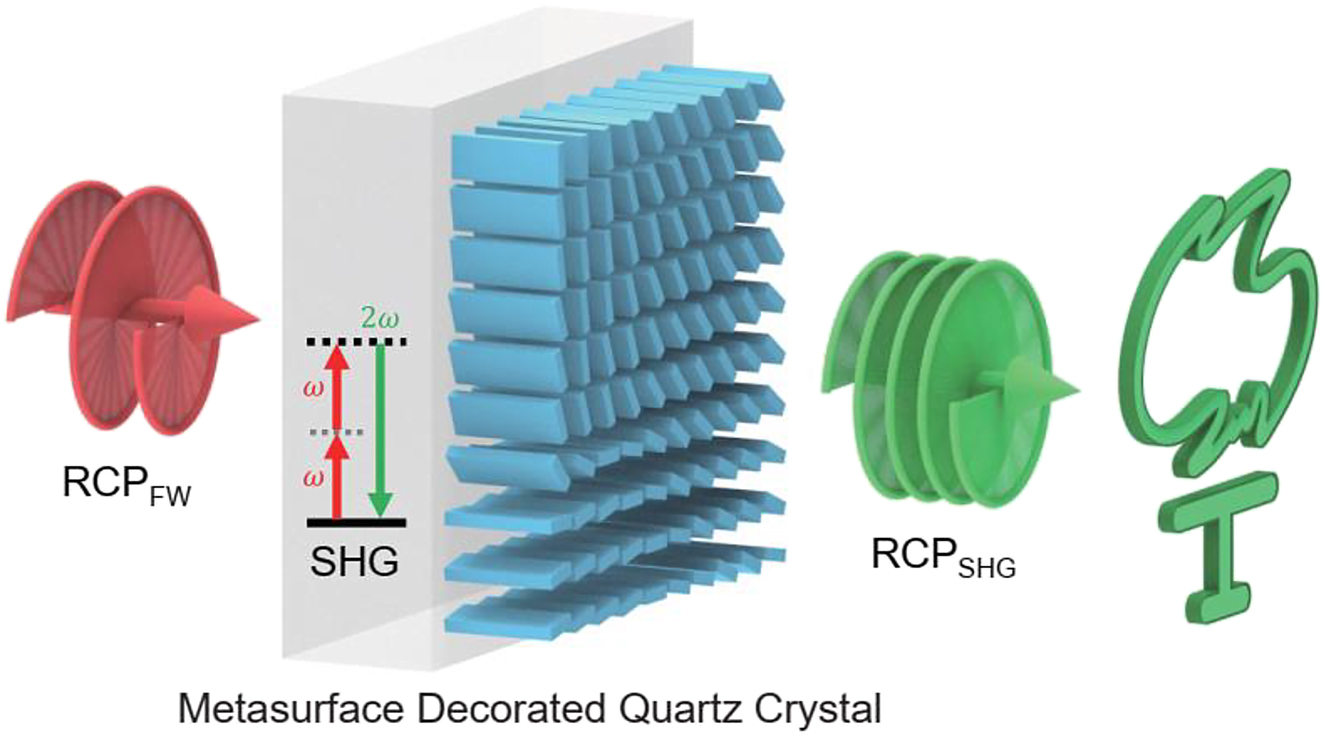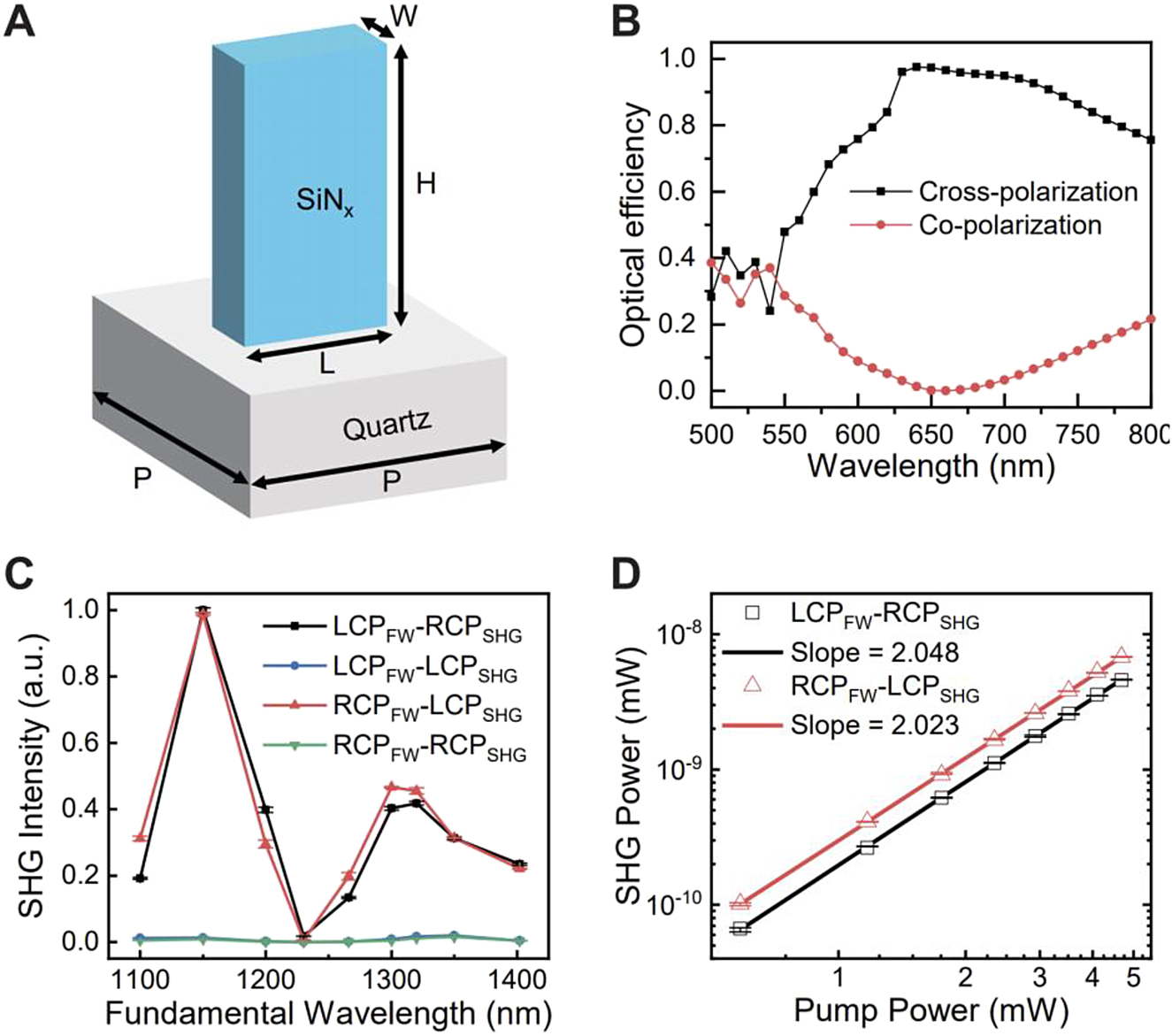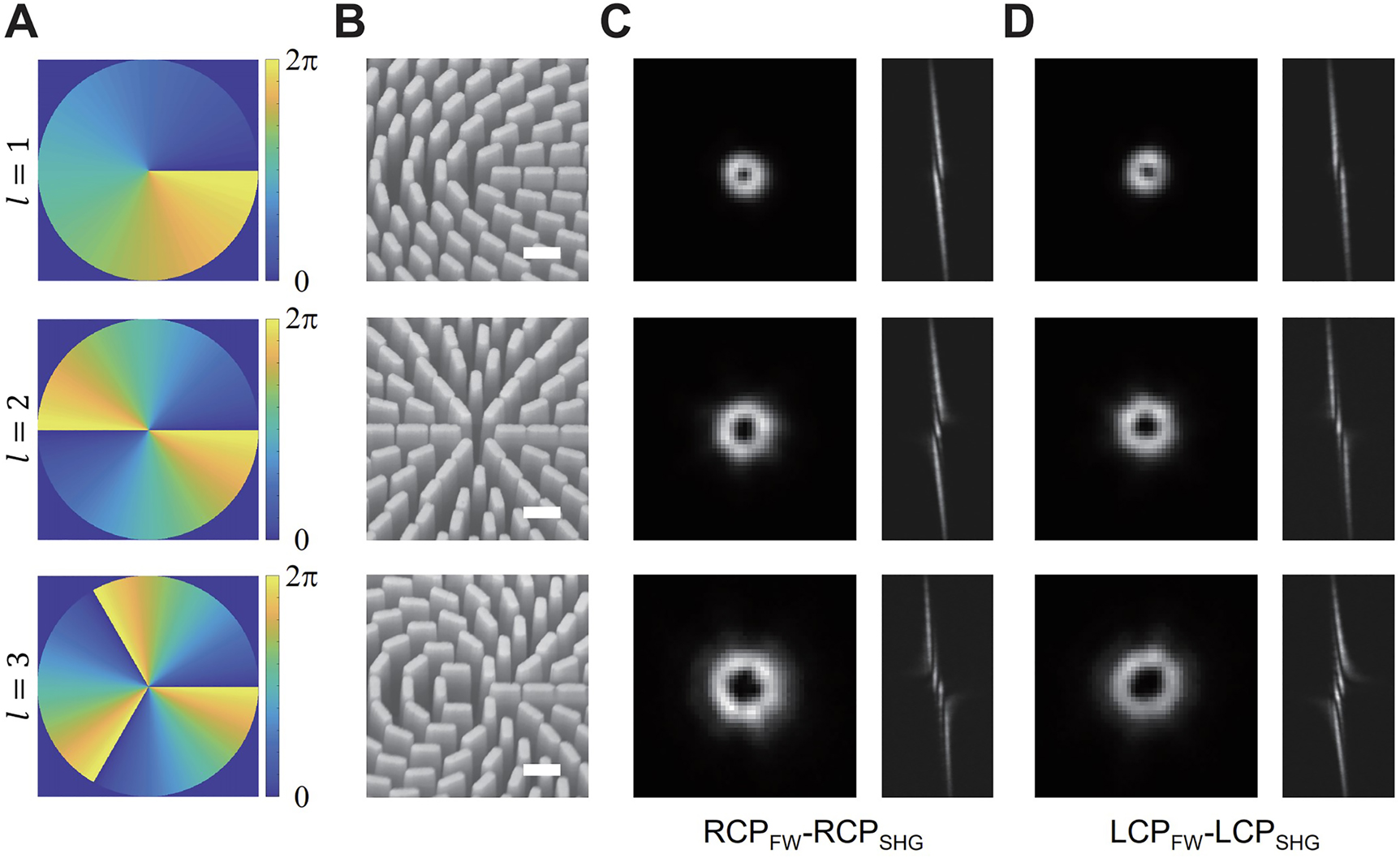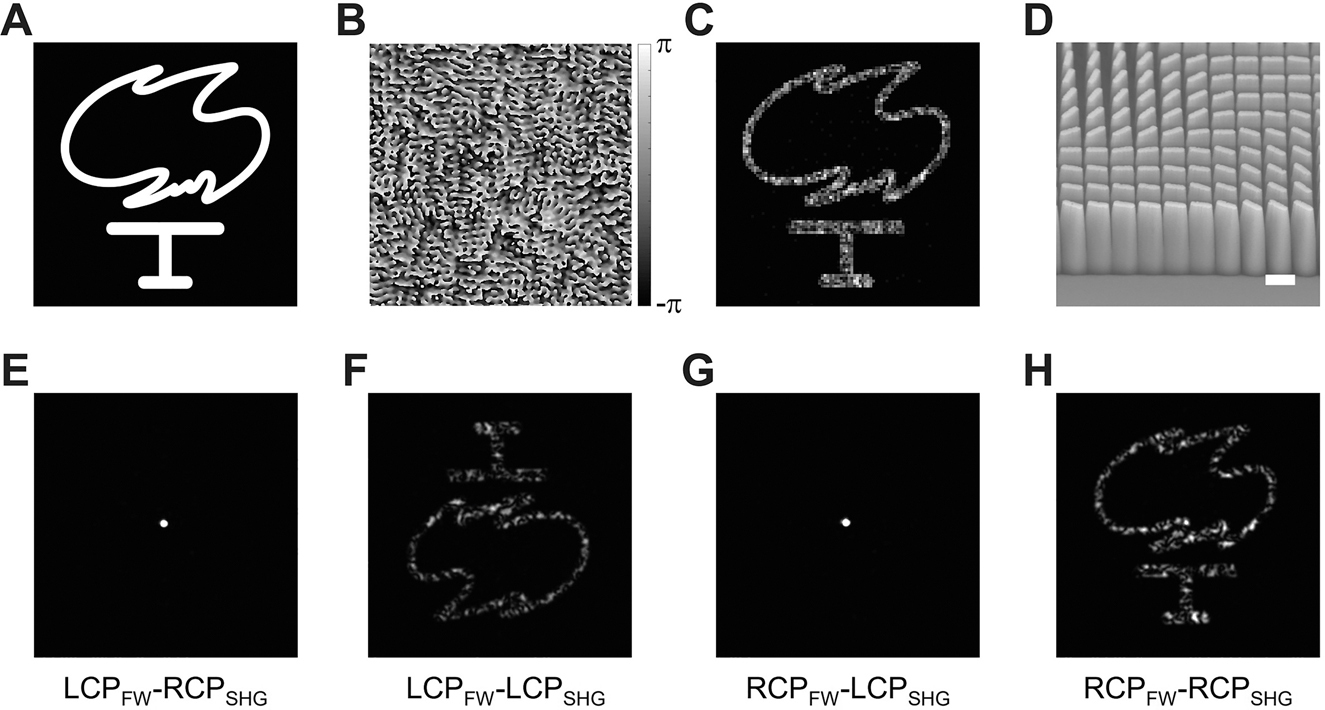Nonlinear wavefront engineering with metasurface decorated quartz crystal
-
Ningbin Mao
Abstract
In linear optical processes, compact and effective wavefront shaping techniques have been developed with the artificially engineered materials and devices in the past decades. Recently, wavefront shaping of light at newly generated frequencies was also demonstrated using nonlinear photonic crystals and metasurfaces. However, the nonlinear wave-shaping devices with both high nonlinear optical efficiency and high wave shaping efficiency are difficult to realize. To circumvent this constraint, we propose the idea of metasurface decorated optical crystal to take the best aspects of both traditional nonlinear crystals and photonic metasurfaces. In the proof-of-concept experiment, we show that a silicon nitride metasurface decorated quartz crystal can be used for the wavefront shaping of the second harmonic waves generated in quartz. With this crystal-metasurface hybrid platform, the nonlinear vortex beam generation and nonlinear holography were successfully demonstrated. The proposed methodology may have important applications in nonlinear structured light generation, super-resolution imaging, and optical information processing, etc.
1 Introduction
Optical wavefront engineering is of critical importance in the areas of optical imaging, optical communication and information processing. In linear optics, photonic metasurface composed of artificially engineered subwavelength structures has revolutionized the technology of wavefront engineering with its unique ability to control light at the subwavelength scale [1]. An abundance of novel photonic metasurfaces, such as the metalenses, vortex beam generators, metasurface holograms, and so on [2], [3], [4], have been developed for multifunctional wavefront engineering. In nonlinear optics, wavefront engineering is also attractive because one can play with light at new wavelengths. The nonlinear wavefront engineering with traditional nonlinear crystal has been extensively studied. For example, optical phase conjugation in second or third-order processes can be used to generate time-reversal wavefront and enables correction of image aberration [5], [6], [7]. In addition, spatial light modulator (SLM) can be used to dynamically control the nonlinear waves generated from the traditional crystals, representing a hybrid way for nonlinear wavefront engineering [8, 9]. It should be noted that bulk crystals lack the ability to realize complicated nonlinear bean shaping, and the SLM is expensive and bulky. Therefore, artificially structured materials, such as the nonlinear photonic crystals and metasurfaces with engineered nonlinearity distribution have emerged as new paradigms to circumvent the above constraints.
In the design of nonlinear photonic crystals, the electric poling technique can be used to locally manipulate the optical nonlinearities. Many interesting applications, such as the generation of nonlinear Airy beams and vortex beams [10, 11], nonlinear Talbot effect [12], have been successfully demonstrated. Recent development in the laser direct writing technique was also used to make three-dimensional nonlinear photonic crystals [13, 14]. These nonlinear photonic crystals can be used for the generation of optical vortex and holographic image at second harmonic frequency [15], [16], [17], [18]. Usually, the size of the unit cell of nonlinear photonic crystal is much larger than the working wavelength of light, this will lead to high-order diffractions and low optical efficiency.
The nonlinear metasurface is a new platform for manipulating nonlinear waves with multiple degrees of freedom, including phase, amplitude, and polarization, etc. [19], [20], [21]. For example, both the dielectric and plasmonic nonlinear metasurfaces have been developed for nonlinear holography [22], [23], [24], [25], [26]. However, the frequency conversion efficiency is usually limited by the short light–matter interaction length on metasurfaces. Sustaining efforts have been devoted to circumvent this limitation. For example, multiquantum-well and epsilon-near-zero material are introduced into the design of nonlinear metal–dielectric hybrid metasurfaces [27], [28], [29].
It has been reported that the metasurface-nonlinear medium hybrid system can be used for nonlinear wavefront engineering. For example, a gold microstructure-conjugated polymer system was utilized to generate vortex beam at third harmonic frequency [30]; a metasurface-tungsten disulfide hybrid platform was developed for focusing and beam steering of the second harmonic waves (SHWs) [31, 32]. In addition, a metalens array together with a nonlinear crystal forms a high-dimensional multiphoton quantum source [33]. It can be found that in most of the previous metasurface-nonlinear media hybrid systems, the metasurface was mainly used to control the wavefront of the fundamental waves (FWs).
In this work, we alternatively propose the concept of metasurface decorated optical crystal to achieve compact and highly efficient nonlinear wavefront engineering. In the proof-of-concept experiment, we used a quartz crystal to generate second harmonic waves and a subsequent dielectric metasurface on top of the quartz to simultaneously control the wavefront of the second harmonic waves. As the schematic illustration shown in Figure 1, the SHWs are generated when the FW excites the quartz crystal. Then, the SHWs from the quartz pass through the dielectric metasurface made of silicon nitride (SiN x ) nanofins, undergoing a phase modulation process. Finally, a holographic image at second harmonic frequency is projected to the far field. The wavefront engineering function of the metasurface is based on the geometric phase introduced by the in-plane rotations of the nanofins. To verify the proposed idea, we experimentally demonstrate nonlinear vortex beam generation and nonlinear optical holography using second harmonic waves generated from the quartz crystal. Our results indicate an easy-to-use and promising platform for realizing compact and efficient nonlinear wavefront engineering and will potentially contribute to the development of nonlinear structured light source and optical information processing, etc.

Schematic illustration of the metasurface decorated quartz crystal for nonlinear wavefront engineering. The second harmonic generation (SHG) process occurs in the quartz crystal. By integrating geometric phase controlled dielectric metasurface on top of the crystal, the wavefront engineering of the second harmonic waves will lead to a holographic image, such as generating a “Torch”. The circular polarization state of the SHW is the same as that of the fundamental wave (FW) because two circular polarization-flipping processes occur subsequently in the quartz crystal and the dielectric metasurface.
2 Design and fabrication of the metasurfaces
In this work, the quartz crystal with thickness of about 250 μm is used as for second harmonic generation (SHG). In the SHG process, the relationship between the induced nonlinear polarization
The wavefront engineering component, namely a linear photonic metasurface fabricated on the quartz crystal, consists of SiN
x
nanofins working at the wavelength of 633 nm. The nanofins are birefringent and act like half-wave plates. We optimized the geometrical parameters of the nanofins by using Lumerical FDTD models. The nanofins can efficiently convert the circularly polarized SHWs into the opposite polarization state and simultaneously impart the predesigned geometric phases into the converted waves. As shown in Figure 2A, the optimized SiN
x
nanofins are of height

Design and linear optical properties of the dielectric metasurfaces and the nonlinear properties of the quartz crystal.
(A) Schematic diagram of the silicon nitride (SiN x ) nanofins, which form the dielectric metasurfaces. The structure parameters are period P = 430 nm, width W = 120 nm, length L = 370 nm, and height H = 1400 nm, respectively. (B) Numerically calculated circular polarization conversion efficiency of the metasurface. The black line indicates the cross-polarization conversion efficiency and the red line corresponds to the copolarization conversion efficiency. (C) The relative SHG intensities from the quartz crystal when the fundamental wavelength is tuned from 1100 to 1400 nm. Four curves correspond to the four circular polarization combinations of the fundamental wave (FW) and the second harmonic wave (SHG). (D) The relation between the SHG power and the pumping power at the fundamental wavelength of 1266 nm. The axes are in log-log scale and the experimental data is fitted via linear regression.
The realization of beam shaping function relies on the capabilities of controlling the phase of the second harmonic waves by virtue of the geometric Pancharatnam–Berry (P–B) phase [35, 36]. In the case of a nanofin, the linear P–B phase is given by
Since the nonlinear frequency conversion mainly occurs in the quartz crystal, we firstly measured the wavelength dependent responses of the SHGs. In the nonlinear optical experiment, a circularly polarized femtosecond laser from an optical parameter oscillator (pulse duration ∼ 250 fs, repetition frequency 80 MHz) was used to excite the quartz crystal. The LCP and RCP components of the SHWs in the transmission direction were recorded (see Supplementary SI-2). The measured SHG responsivities of the quartz crystal are presented in Figure 2C. It clearly shows that the cross-polarization SHG signals (LCPFW–RCPSHG and RCPFW–LCPSHG) are much stronger than the copolarization signals (LCPFW–LCPSHG and RCPFW–RCPSHG), which is consistent with the theoretical analysis. The SHG responses at the target wavelength of 1266 nm are considered to be strong enough for the proof-of-concept demonstration. As shown in Figure 2D, we also measured the quartz crystal’s power-dependent SHG intensities at the fundamental wavelength of 1266 nm. The intensities of SHG signals are quadratic to that of the FW, a characteristic of the second-order nonlinear optical processes.
3 Characterizations of nonlinear wavefront engineering
Optical vortex beam generation is an important topic in wavefront engineering. A vortex beam contains a phase factor of
In the first experiment, we used a metasurface decorated quartz crystal to generate nonlinear vortex beam with orbital angular momentum values of

Generation of second harmonic vortex beams from the metasurface decorated quartz crystal.
(A) The required phase distributions for the generation of second harmonic vortex beams with orbital angular momentum of
As discussed above, the metasurface devices are designed to be excited by the FWs of RCP state. The measured intensity profiles of the SHG beams of the designed polarization configuration (RCPFW–RCPSHG) are shown in Figure 3C. The SHG intensity distributions were captured by using a spherical lens (left panel) and a cylindrical lens (right panel), respectively. The increasing size of the rings reflect that the vortex beams have different azimuthal indices, whose value and sign can be identified from the number and orientation of the dark fringes of the intensity patterns imaged with a cylindrical lens. The identified orbital angular momentum of the SHG beams agrees well with the designed value of
The metasurface decorated quartz crystal was further utilized to generate nonlinear holographic images. The Gerchberg–Saxton phase retrieval algorithm was used to design the phase-type hologram [44]. The target binary image and the generated phase distribution

Generation of the second harmonic holographic image from the metasurface decorated quartz crystal.
(A) The target “Torch” image. (B) The required phase distribution calculated by using the Gerchberg–Saxton phase retrieval algorithm. The phase hologram has 201 × 201 square pixels; each pixel size is of 430 × 430 nm2. The working wavelength is 633 nm. (C) Numerically reconstructed image from the phase distribution in (B). (D) The SEM image of the dielectric metasurface on top of the quartz crystal. Scale bar: 500 nm. (E–H) Experimentally recorded SHG images from the device at the fundamental wavelength of 1266 nm. Four circular polarization combinations of the FW and the second harmonic wave (SHG) are presented.
4 Conclusions
To summarize, we proposed the concept of metasurface decorated optical crystal as a platform for arbitrary nonlinear wavefront engineering. Based on this idea, we designed and fabricated several dielectric metasurfaces on top of the quartz crystal to demonstrate the generations of vortex beams and holographic images at the second harmonic frequency. The proposed method in this work is compatible with traditional photolithography and laser direct writing techniques, so that various crystal-metasurface hybrid systems can be designed. It is expected that the concept of metasurface decorated optical crystal may provide great potential for nonlinear wavefront engineering and optical information processing.
Funding source: National Natural Science Foundation of China
Award Identifier / Grant number: 91950114
Award Identifier / Grant number: 11774145
Funding source: Guangdong Provincial Innovation and Entrepreneurship Project
Award Identifier / Grant number: 2017ZT07C071
Funding source: Natural Science Foundation of Shenzhen Innovation Commission
Award Identifier / Grant number: JCYJ20200109140808088
Funding source: Shenzhen DRC Project
Award Identifier / Grant number: [2018]1433
-
Author contribution: All the authors have accepted responsibility for the entire content of this submitted manuscript and approved submission.
-
Research funding: This research was supported by National Natural Science Foundation of China (91950114, 11774145), Guangdong Provincial Innovation and Entrepreneurship Project (2017ZT07C071), Natural Science Foundation of Shenzhen Innovation Commission (JCYJ20200109140808088), and Shenzhen DRC Project [2018]1433.
-
Conflict of interest statement: The authors declare no competing interests.
References
[1] N. Yu, P. Genevet, M. Kats, et al.., “Light propagation with phase discontinuities: generalized laws of reflection and refraction,” Science, vol. 334, pp. 333–337, 2011. https://doi.org/10.1126/science.1210713.Search in Google Scholar PubMed
[2] X. Chen, L. Huang, H. Muhlenbernd, et al.., “Dual-polarity plasmonic metalens for visible light,” Nat. Commun., vol. 3, p. 1198, 2012. https://doi.org/10.1038/ncomms2207.Search in Google Scholar PubMed PubMed Central
[3] A. Arbabi, Y. Horie, M. Bagheri, and A. Faraon, “Dielectric metasurfaces for complete control of phase and polarization with subwavelength spatial resolution and high transmission,” Nat. Nanotechnol., vol. 10, pp. 937–943, 2015. https://doi.org/10.1038/nnano.2015.186.Search in Google Scholar PubMed
[4] Z. Deng and G. Li, “Metasurface optical holography,” Mater. Today Phys., vol. 3, pp. 16–32, 2017. https://doi.org/10.1016/j.mtphys.2017.11.001.Search in Google Scholar
[5] A. Yariv and D. Pepper, “Amplified reflection, phase conjugation, and oscillation in degenerate four-wave mixing,” Opt. Lett., vol. 1, pp. 16–18, 1977. https://doi.org/10.1364/ol.1.000016.Search in Google Scholar PubMed
[6] K. MacDonald, W. Tompkin, and R. Boyd, “Passive one-way aberration correction using four-wave mixing,” Opt. Lett., vol. 13, pp. 485–487, 1988. https://doi.org/10.1364/ol.13.000485.Search in Google Scholar PubMed
[7] X. Zou, P. Zhao, P. Hong, et al.., “Restoration of blurred images due to phase distortion based on polarization-insensitive phase conjugation in second-order nonlinear medium,” Opt. Lett., vol. 38, pp. 3054–3056, 2013. https://doi.org/10.1364/ol.38.003054.Search in Google Scholar
[8] H. Liu, J. Li, X. Fang, X. Zhao, Y. Zheng, and X. Chen, “Dynamic computer-generated nonlinear-optical holograms,” Phys. Rev. A, vol. 96, p. 023801, 2017. https://doi.org/10.1103/physreva.96.023801.Search in Google Scholar
[9] H. Liu, X. Zhao, H. Li, Y. Zheng, and X. Chen, “Dynamic computer-generated nonlinear optical holograms in a non-collinear second-harmonic generation process,” Opt. Lett., vol. 43, pp. 3236–3239, 2018. https://doi.org/10.1364/ol.43.003236.Search in Google Scholar PubMed
[10] T. Ellenbogen, N. Voloch-Bloch, A. Ganany-Padowicz, and A. Arie, “Nonlinear generation and manipulation of Airy beams,” Nat. Photonics, vol. 3, pp. 395–398, 2009. https://doi.org/10.1038/nphoton.2009.95.Search in Google Scholar
[11] N. Voloch-Bloch, K. Shemer, A. Shapira, R. Shiloh, I. Juwiler, and A. Arie, “Twisting light by nonlinear photonic crystals,” Phys. Rev. Lett., vol. 108, p. 233902, 2012. https://doi.org/10.1103/physrevlett.108.233902.Search in Google Scholar PubMed
[12] Y. Zhang, J. Wen, S. Zhu, and M. Xiao, “Nonlinear Talbot effect,” Phys. Rev. Lett., vol. 104, p. 183901, 2010. https://doi.org/10.1103/physrevlett.104.183901.Search in Google Scholar PubMed
[13] T. Xu, K. Switkowski, X. Chen, et al.., “Three-dimensional nonlinear photonic crystal in ferroelectric barium calcium titanate,” Nat. Photonics, vol. 12, pp. 591–595, 2018. https://doi.org/10.1038/s41566-018-0225-1.Search in Google Scholar
[14] D. Wei, C. Wang, H. Wang, et al.., “Experimental demonstration of a three-dimensional lithium niobate nonlinear photonic crystal,” Nat. Photonics, vol. 12, pp. 596–600, 2018. https://doi.org/10.1038/s41566-018-0240-2.Search in Google Scholar
[15] X. Hong, B. Yang, C. Zhang, Y. Qin, and Y. Zhu, “Nonlinear volume holography for wave-front engineering,” Phys. Rev. Lett., vol. 113, p. 163902, 2014. https://doi.org/10.1103/physrevlett.113.163902.Search in Google Scholar PubMed
[16] S. Liu, K. Switkowski, X. Chen, et al.., “Nonlinear wavefront shaping with optically induced three-dimensional nonlinear photonic crystals,” Nat. Commun., vol. 10, p. 3208, 2019. https://doi.org/10.1038/s41467-019-11114-y.Search in Google Scholar PubMed PubMed Central
[17] D. Wei, C. Wang, X. Xu, et al.., “Efficient nonlinear beam shaping in three dimensional lithium niobate nonlinear photonic crystals,” Nat. Commun., vol. 10, p. 4193, 2019. https://doi.org/10.1038/s41467-019-12251-0.Search in Google Scholar PubMed PubMed Central
[18] P. Chen, C. Wang, D. Wei, et al.., “Quasi-phase-matching-division multiplexing holography in a three-dimensional nonlinear photonic crystal,” Light Sci. Appl., vol. 10, p. 146, 2021. https://doi.org/10.1038/s41377-021-00588-5.Search in Google Scholar PubMed PubMed Central
[19] G. Li, S. Zhang, and T. Zentgraf, “Nonlinear photonic metasurfaces,” Nat. Rev. Mater., vol. 2, p. 17010, 2017. https://doi.org/10.1038/natrevmats.2017.10.Search in Google Scholar
[20] Y. Kivshar, “All-dielectric meta-optics and non-linear nanophotonics,” Natl. Sci. Rev., vol. 5, pp. 144–158, 2018. https://doi.org/10.1093/nsr/nwy017.Search in Google Scholar
[21] B. Sain, C. Meier, and T. Zentgraf, “Nonlinear optics in all-dielectric nanoantennas and metasurfaces: a review,” Adv. Photonics, vol. 1, p. 024002, 2019. https://doi.org/10.1117/1.ap.1.2.024002.Search in Google Scholar
[22] W. Ye, F. Zeuner, X. Li, et al.., “Spin and wavelength multiplexed nonlinear metasurface holography,” Nat. Commun., vol. 7, p. 11930, 2016. https://doi.org/10.1038/ncomms11930.Search in Google Scholar PubMed PubMed Central
[23] E. Almeida, O. Bitton, and Y. Prior, “Nonlinear metamaterials for holography,” Nat. Commun., vol. 7, p. 12533, 2016. https://doi.org/10.1038/ncomms12533.Search in Google Scholar PubMed PubMed Central
[24] L. Wang, S. Kruk, K. Koshelev, I. Kravchenko, B. Luther-Davies, and Y. Kivshar, “Nonlinear wavefront control with all-dielectric metasurfaces,” Nano Lett., vol. 18, pp. 3978–3984, 2018. https://doi.org/10.1021/acs.nanolett.8b01460.Search in Google Scholar PubMed
[25] Y. Gao, Y. Fan, Y. Wang, W. Yang, Q. Song, and S. Xiao, “Nonlinear holographic all-dielectric metasurfaces,” Nano Lett., vol. 18, pp. 8054–8061, 2018. https://doi.org/10.1021/acs.nanolett.8b04311.Search in Google Scholar PubMed
[26] N. Mao, J. Deng, X. Zhang, et al.., “Nonlinear diatomic metasurface for real and Fourier space imaging,” Nano Lett., vol. 20, pp. 7463–7468, 2020. https://doi.org/10.1021/acs.nanolett.0c02910.Search in Google Scholar PubMed
[27] J. Lee, M. Tymchenko, C. Argyropoulos, et al.., “Giant nonlinear response from plasmonic metasurfaces coupled to intersubband transitions,” Nature, vol. 511, pp. 65–69, 2014. https://doi.org/10.1038/nature13455.Search in Google Scholar PubMed
[28 ] M. Alam, S. Schulz, J. Upham, I. Leon, and R. Boyd, “Large optical nonlinearity of nanoantennas coupled to an epsilon-near-zero material,” Nat. Photonics, vol. 12, pp. 79–83, 2018. https://doi.org/10.1038/s41566-017-0089-9.Search in Google Scholar
[29] J. Deng, Y. Tang, S. Chen, K. Li, A. Zayats, and G. Li, “Giant enhancement of second-order nonlinearity of epsilon-near-zero medium by a plasmonic metasurface,” Nano Lett., vol. 20, pp. 5421–5427, 2020. https://doi.org/10.1021/acs.nanolett.0c01810.Search in Google Scholar PubMed
[30] G. Li, S. Chen, Y. Cai, S. Zhang, and K. Cheah, “Third harmonic generation of optical vortices using holography-based gold-fork microstructure,” Adv. Opt. Mater., vol. 2, pp. 389–393, 2014. https://doi.org/10.1002/adom.201300496.Search in Google Scholar
[31] J. Chen, K. Wang, H. Long, et al.., “Tungsten disulfide-gold nanohole hybrid metasurfaces for nonlinear metalenses in the visible region,” Nano Lett., vol. 18, pp. 1344–1350, 2018. https://doi.org/10.1021/acs.nanolett.7b05033.Search in Google Scholar PubMed
[32] G. Hu, X. Hong, K. Wang, et al.., “Coherent steering of nonlinear chiral valley photons with a synthetic Au-WS2 metasurface,” Nat. Photonics, vol. 13, pp. 467–472, 2019. https://doi.org/10.1038/s41566-019-0399-1.Search in Google Scholar
[33] L. Li, Z. Liu, X. Ren, et al.., “Metalens-array-based high-dimensional and multi-photon quantum source,” Science, vol. 368, pp. 1487–1490, 2020. https://doi.org/10.1126/science.aba9779.Search in Google Scholar PubMed
[34] R. Boyd, Nonlinear Optics, 4th ed. Boston, Academic Press, 2020.Search in Google Scholar
[35] S. Pancharatnam, “Generalized theory of interference and its applications,” Proc. Indian Acad. Sci. Sect. A, vol. 44, pp. 398–417, 1956. https://doi.org/10.1007/bf03046095.Search in Google Scholar
[36] M. Berry, “Quantal phase factors accompanying adiabatic changes,” Proc. Roy. Soc. Lond. A, vol. 392, pp. 45–57, 1984.10.1142/9789813221215_0006Search in Google Scholar
[37] J. W. Goodman, Introduction to Fourier Optics, 4th ed. New York, W. H. Freeman, 2017.Search in Google Scholar
[38] L. Allen, M. W. Beijersbergen, R. Spreeuw, and J. Woerdman, “Orbital angular momentum of light and the transformation of Laguerre-Gaussian laser modes,” Phys. Rev. A, vol. 45, pp. 8185–8189, 1992. https://doi.org/10.1103/physreva.45.8185.Search in Google Scholar PubMed
[39] K. Bliokh and F. Nori, “Transverse and longitudinal angular momenta of light,” Phys. Rep., vol. 592, pp. 1–38, 2015. https://doi.org/10.1016/j.physrep.2015.06.003.Search in Google Scholar
[40] F. Tamburini, G. Anzolin, G. Umbriaco, A. Bianchini, and C. Barbieri, “Overcoming the Rayleigh criterion limit with optical vortices,” Phys. Rev. Lett., vol. 97, p. 163903, 2006. https://doi.org/10.1103/physrevlett.97.163903.Search in Google Scholar
[41] D. G. Grier, “A revolution in optical manipulation,” Nature, vol. 424, pp. 810–816, 2003. https://doi.org/10.1038/nature01935.Search in Google Scholar PubMed
[42] J. Wang, J. Yang, I. Fazal, et al.., “Terabit free-space data transmission employing orbital angular momentum multiplexing,” Nat. Photonics, vol. 6, pp. 488–496, 2012. https://doi.org/10.1038/nphoton.2012.138.Search in Google Scholar
[43] J. Leach, J. Barry, R. Jacqui, et al.., “Quantum correlations in optical angle-orbital angular momentum variables,” Science, vol. 329, pp. 662–665, 2010. https://doi.org/10.1126/science.1190523.Search in Google Scholar PubMed
[44] R. W. Gerchberg and W. O. Saxton, “Practical algorithm for the determination of phase from image and diffraction plane pictures,” Optik, vol. 35, pp. 237–246, 1972.Search in Google Scholar
Supplementary Material
The online version of this article offers supplementary material (https://doi.org/10.1515/nanoph-2021-0464).
© 2021 Ningbin Mao et al., published by De Gruyter, Berlin/Boston
This work is licensed under the Creative Commons Attribution 4.0 International License.
Articles in the same Issue
- Frontmatter
- Editorial
- Photonic angular momentum: progress and perspectives
- Reviews
- Spiraling light: from donut modes to a Magnus effect analogy
- Orbital angular momentum and beyond in free-space optical communications
- Research Articles
- Parabolic-accelerating vector waves
- Experimental synthesis of partially coherent beam with controllable twist phase and measuring its orbital angular momentum
- Harnessing of inhomogeneously polarized Hermite–Gaussian vector beams to manage the 3D spin angular momentum density distribution
- Introducing Berry phase gradients along the optical path via propagation-dependent polarization transformations
- Angular momentum redirection phase of vector beams in a non-planar geometry
- Transverse shifts and time delays of spatiotemporal vortex pulses reflected and refracted at a planar interface
- Spatiotemporal optical vortices with arbitrary orbital angular momentum orientation by astigmatic mode converters
- Digital toolbox for vector field characterization
- Phase conjugation of twisted Gaussian Schell model beams in stimulated down-conversion
- Spin to orbital angular momentum transfer in frequency up-conversion
- Deep-learning-based recognition of multi-singularity structured light
- Reconfigurable terahertz metasurfaces coherently controlled by wavelength-scale-structured light
- Nonlinear wavefront engineering with metasurface decorated quartz crystal
- Nanostructured silica spin–orbit optics for modal vortex beam shaping
- Spin separation based on-chip optical polarimeter via inverse design
- Photonic integrated chip enabling orbital angular momentum multiplexing for quantum communication
- Fabrication of lithium niobate fork grating by laser-writing-induced selective chemical etching
- High-power thin-disk lasers emitting beams with axially-symmetric polarizations
- The generation of femtosecond optical vortex beams with megawatt powers directly from a fiber based Mamyshev oscillator
- Generation of hexagonal close-packed ring-shaped structures using an optical vortex
- A phase-to-intensity strategy of angular velocity measurement based on photonic orbital angular momentum
- SDM transmission of orbital angular momentum mode channels over a multi-ring-core fibre
- Dynamic aerosol and dynamic air-water interface curvature effects on a 2-Gbit/s free-space optical link using orbital-angular-momentum multiplexing
Articles in the same Issue
- Frontmatter
- Editorial
- Photonic angular momentum: progress and perspectives
- Reviews
- Spiraling light: from donut modes to a Magnus effect analogy
- Orbital angular momentum and beyond in free-space optical communications
- Research Articles
- Parabolic-accelerating vector waves
- Experimental synthesis of partially coherent beam with controllable twist phase and measuring its orbital angular momentum
- Harnessing of inhomogeneously polarized Hermite–Gaussian vector beams to manage the 3D spin angular momentum density distribution
- Introducing Berry phase gradients along the optical path via propagation-dependent polarization transformations
- Angular momentum redirection phase of vector beams in a non-planar geometry
- Transverse shifts and time delays of spatiotemporal vortex pulses reflected and refracted at a planar interface
- Spatiotemporal optical vortices with arbitrary orbital angular momentum orientation by astigmatic mode converters
- Digital toolbox for vector field characterization
- Phase conjugation of twisted Gaussian Schell model beams in stimulated down-conversion
- Spin to orbital angular momentum transfer in frequency up-conversion
- Deep-learning-based recognition of multi-singularity structured light
- Reconfigurable terahertz metasurfaces coherently controlled by wavelength-scale-structured light
- Nonlinear wavefront engineering with metasurface decorated quartz crystal
- Nanostructured silica spin–orbit optics for modal vortex beam shaping
- Spin separation based on-chip optical polarimeter via inverse design
- Photonic integrated chip enabling orbital angular momentum multiplexing for quantum communication
- Fabrication of lithium niobate fork grating by laser-writing-induced selective chemical etching
- High-power thin-disk lasers emitting beams with axially-symmetric polarizations
- The generation of femtosecond optical vortex beams with megawatt powers directly from a fiber based Mamyshev oscillator
- Generation of hexagonal close-packed ring-shaped structures using an optical vortex
- A phase-to-intensity strategy of angular velocity measurement based on photonic orbital angular momentum
- SDM transmission of orbital angular momentum mode channels over a multi-ring-core fibre
- Dynamic aerosol and dynamic air-water interface curvature effects on a 2-Gbit/s free-space optical link using orbital-angular-momentum multiplexing

